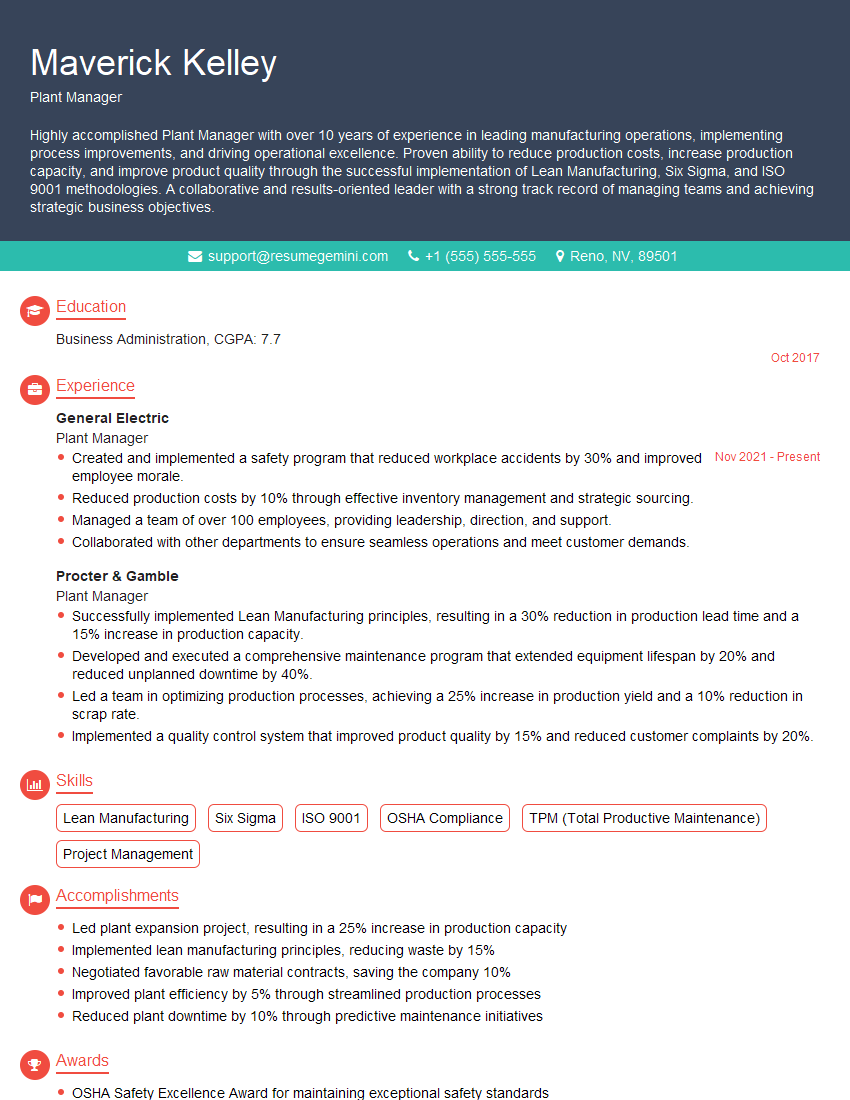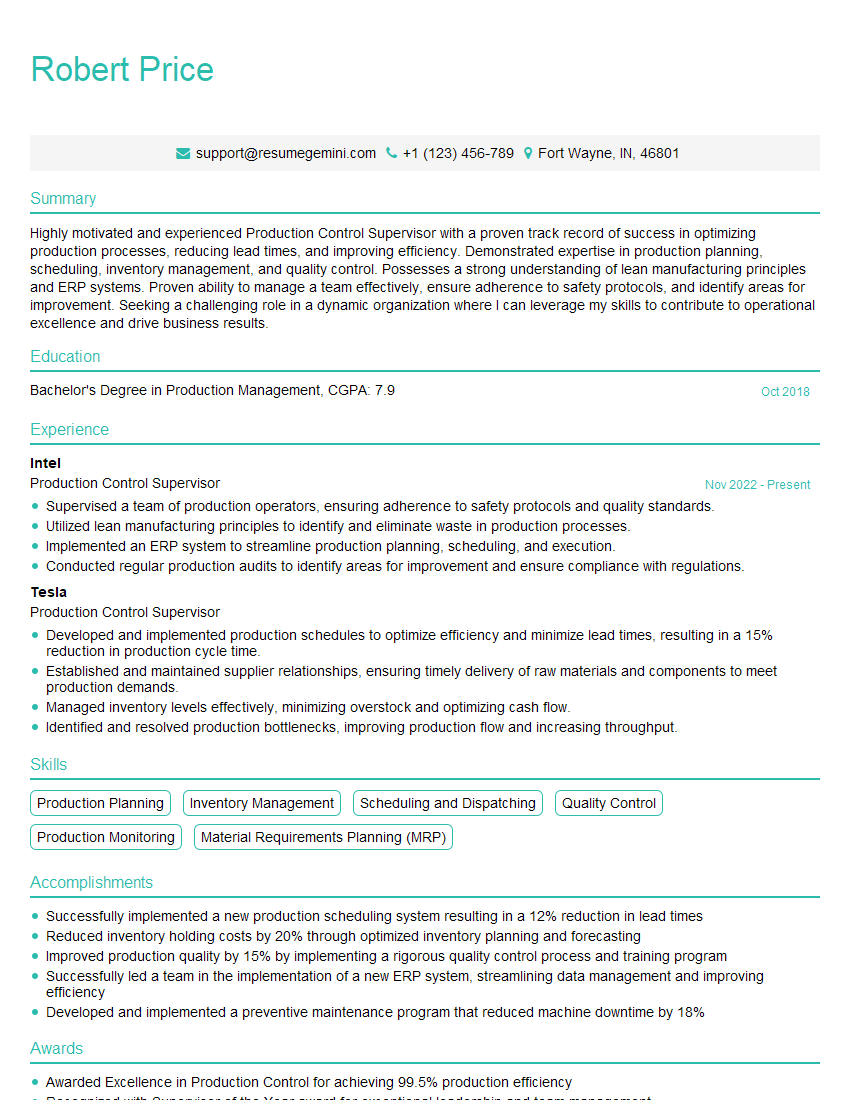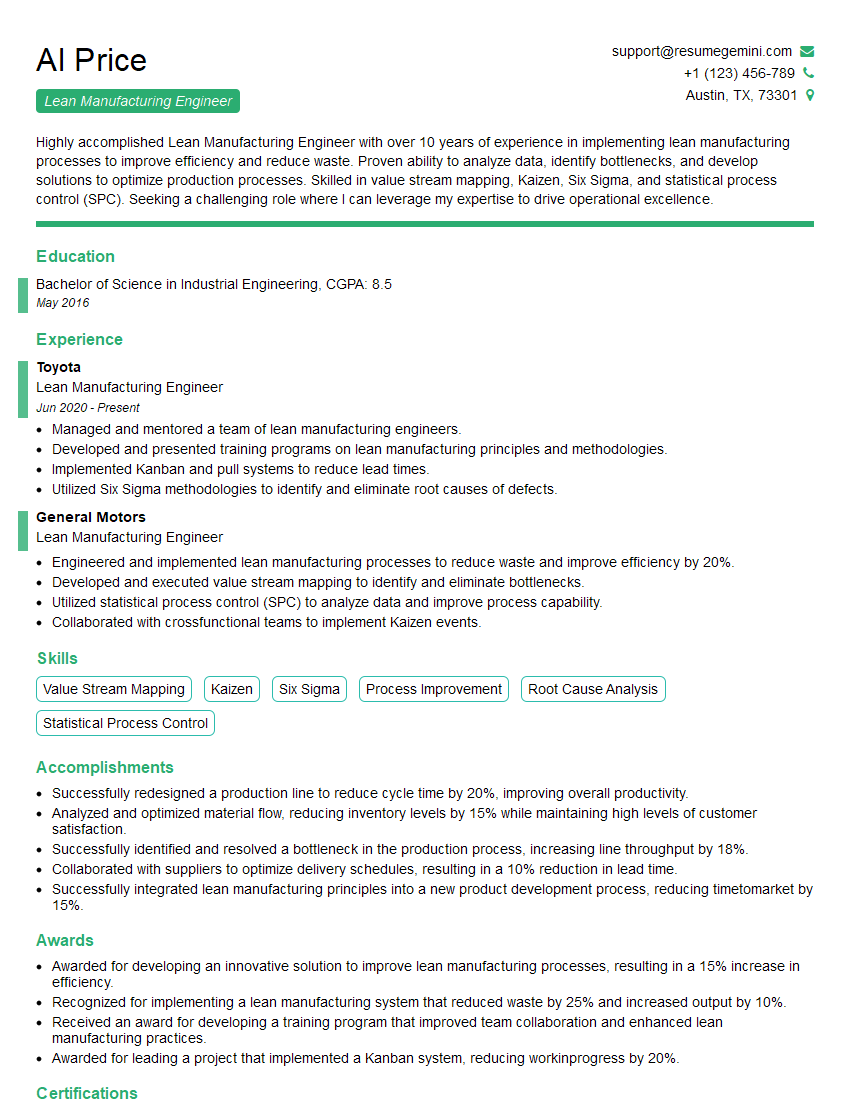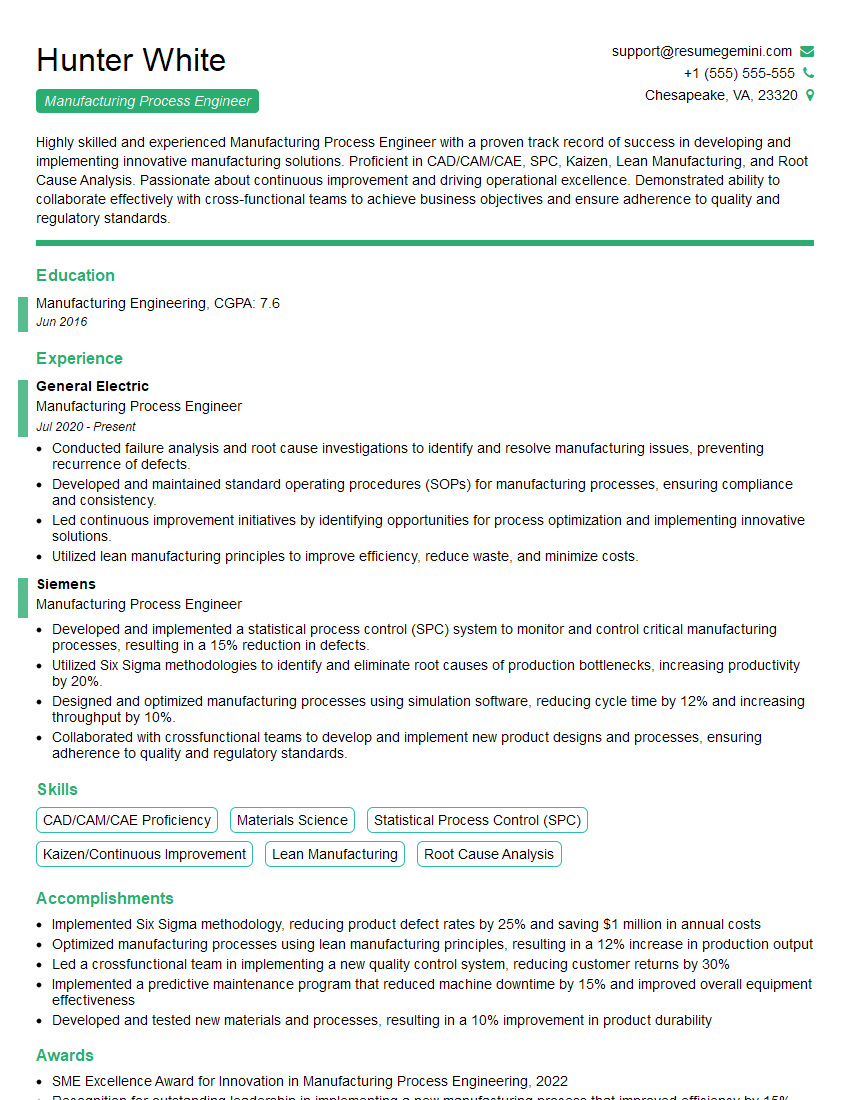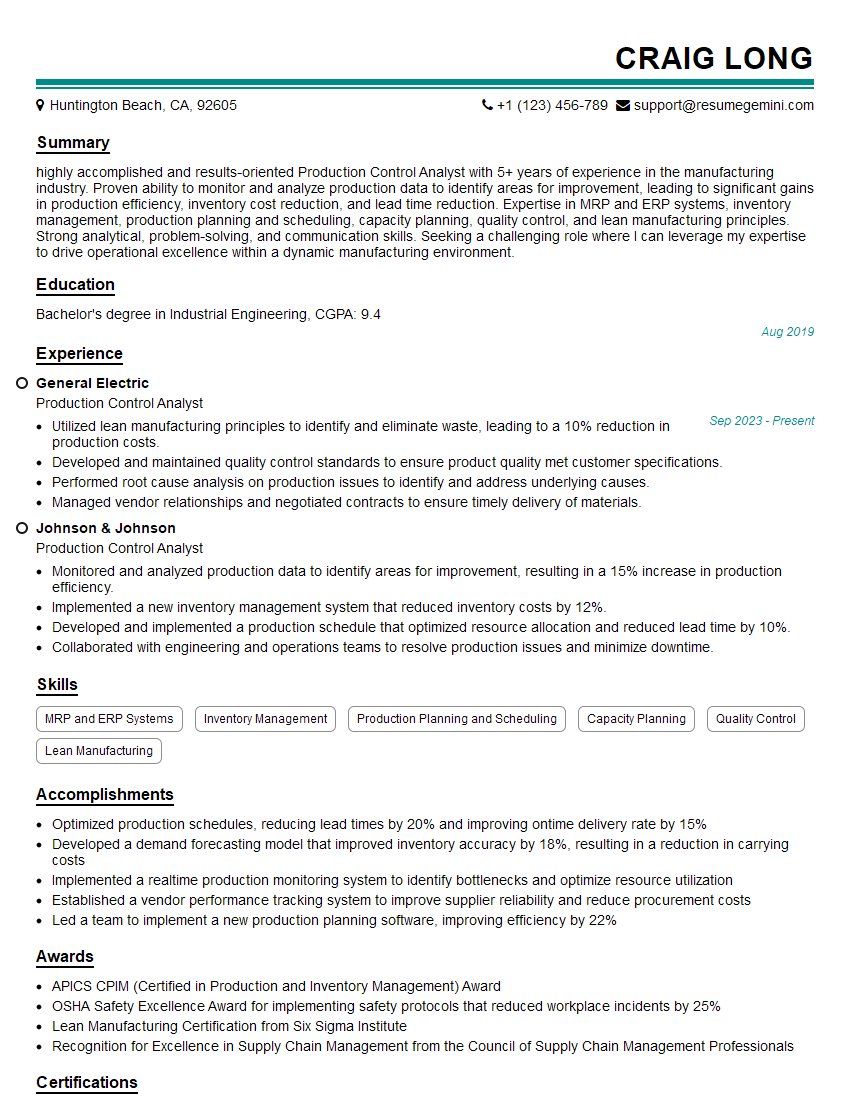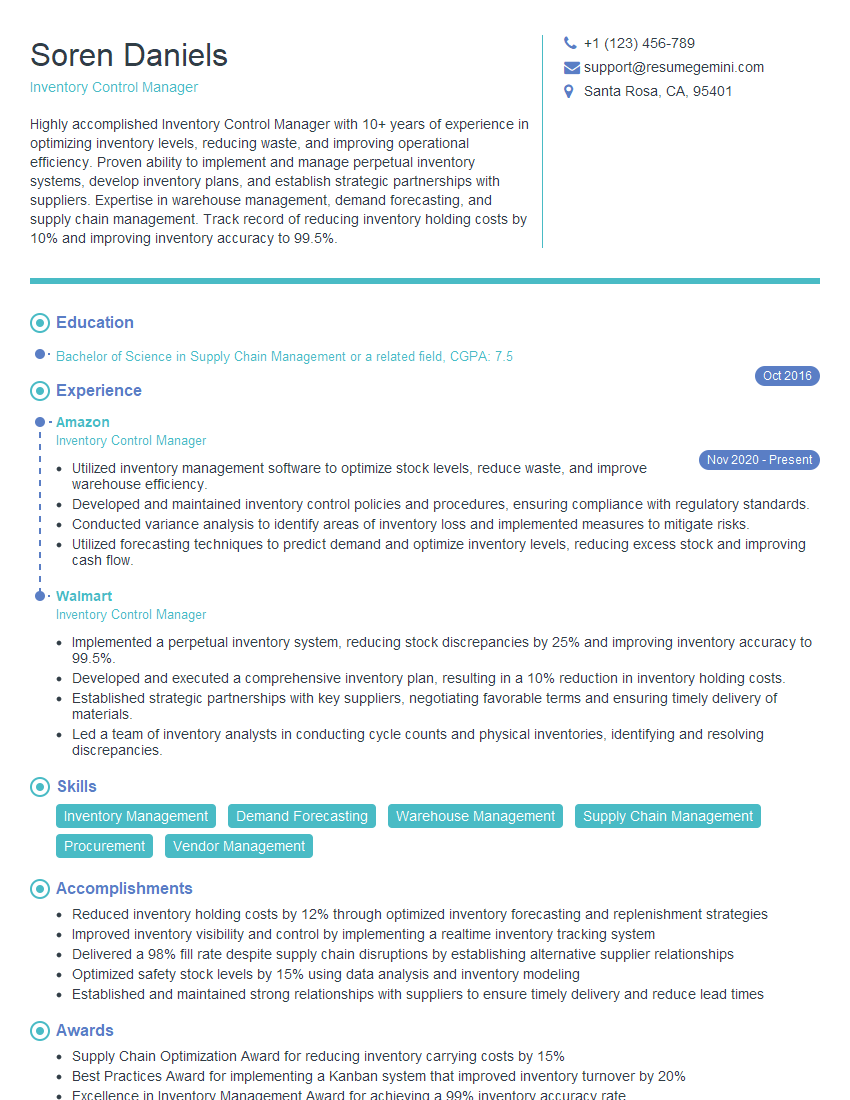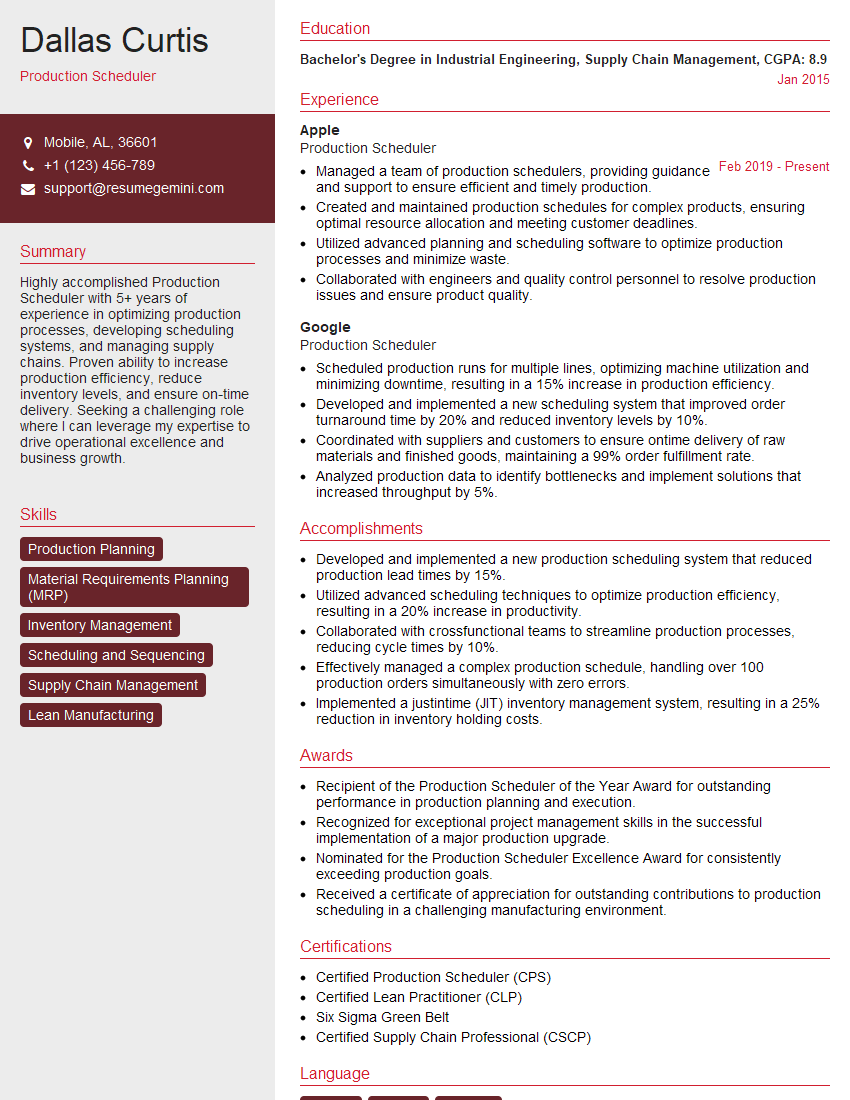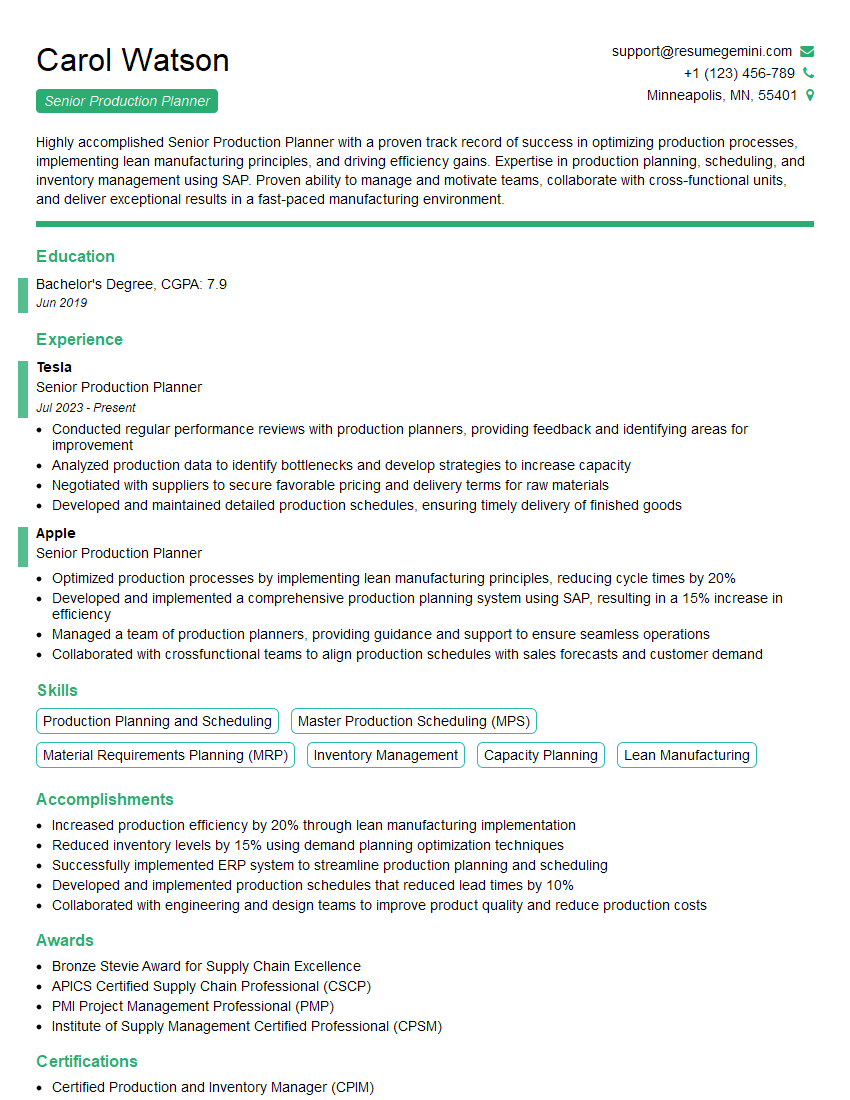The thought of an interview can be nerve-wracking, but the right preparation can make all the difference. Explore this comprehensive guide to Use production planning and control procedures interview questions and gain the confidence you need to showcase your abilities and secure the role.
Questions Asked in Use production planning and control procedures Interview
Q 1. Explain the difference between Master Production Scheduling (MPS) and Material Requirements Planning (MRP).
Master Production Scheduling (MPS) and Material Requirements Planning (MRP) are both crucial components of production planning, but they operate at different levels. Think of MPS as the high-level strategic plan, outlining what finished goods will be produced and when, while MRP is the detailed tactical plan that figures out all the raw materials and components needed to support the MPS.
MPS focuses on the finished goods. It’s a time-phased plan showing the quantity of each end product to be manufactured over a specific period. It considers factors like sales forecasts, available capacity, and inventory levels. A simple example: An MPS might specify producing 1000 widgets in week 1, 1500 in week 2, and 800 in week 3.
MRP, on the other hand, takes the MPS as input and explodes it down to determine the precise quantities and timing of all the raw materials, subassemblies, and components needed to manufacture those finished goods. It considers lead times for procurement and manufacturing. If a widget requires two bolts and one spring, MRP calculates how many bolts and springs are needed each week to meet the MPS quantities.
In essence, MPS tells you what to produce, while MRP tells you how to produce it by detailing the necessary materials and their timing.
Q 2. Describe your experience with different production planning techniques (e.g., Kanban, Lean, Six Sigma).
Throughout my career, I’ve had extensive experience implementing and optimizing various production planning techniques. I’ve successfully used Kanban, Lean, and Six Sigma methodologies in different manufacturing environments.
- Kanban: I implemented a Kanban system in a small electronics assembly facility, significantly reducing lead times and improving workflow visibility. We used visual cues (Kanban cards) to manage the flow of materials and work-in-progress, minimizing inventory and optimizing production based on actual customer demand. The result was a 20% reduction in inventory and a 15% decrease in lead times.
- Lean Manufacturing: In a larger automotive parts supplier, I led a Lean initiative focusing on value stream mapping to identify and eliminate waste in the production process. By streamlining processes and reducing unnecessary steps, we achieved a 10% increase in productivity and a 5% reduction in defects.
- Six Sigma: I applied Six Sigma methodologies (DMAIC – Define, Measure, Analyze, Improve, Control) to reduce defects in a high-precision machining operation. Through rigorous data analysis and process improvements, we decreased the defect rate from 3% to less than 0.5%.
My experience shows that the best approach is often a hybrid, tailoring the methods to the specific needs of the production environment. For example, you might combine Kanban’s visual management with Lean’s focus on waste reduction and Six Sigma’s data-driven approach to continuous improvement.
Q 3. How do you handle unexpected production disruptions or delays?
Unexpected disruptions are inevitable in production. My approach involves a proactive and reactive strategy.
Proactive Measures: This includes maintaining a safety stock of critical materials, having contingency plans for key suppliers, and regularly reviewing and updating the MPS and MRP to account for potential risks. Regularly reviewing supplier performance is vital. For example, if a supplier has a history of late deliveries, we might explore alternative sources or build additional buffer stock.
Reactive Measures: When disruptions occur, my approach follows a structured process:
- Identify the problem: Quickly assess the nature and severity of the disruption.
- Quantify the impact: Determine the effect on production schedules and customer deliveries.
- Develop solutions: Explore options, such as rescheduling production, expediting materials, or subcontracting work.
- Implement the solution: Put the chosen solution into action immediately.
- Monitor and adjust: Track the effectiveness of the solution and make adjustments as needed.
For instance, if a machine breaks down, we’d immediately assess the impact on the production schedule, explore options like repair, temporary replacement, or rescheduling, and then communicate the changes to all relevant parties. Effective communication is key during such times.
Q 4. What metrics do you use to measure the effectiveness of production planning and control?
Measuring the effectiveness of production planning and control requires a balanced scorecard approach, looking at both efficiency and effectiveness metrics. Some key metrics I regularly use are:
- On-Time Delivery Rate (OTDR): The percentage of orders delivered on or before the due date.
- Inventory Turnover: The number of times inventory is sold or used in a given period. A higher turnover suggests efficient inventory management.
- Production Lead Time: The time it takes to complete a product from order to delivery.
- Manufacturing Cycle Efficiency (MCE): The ratio of value-added time to total lead time.
- Defect Rate: The percentage of defective products produced.
- Capacity Utilization: The percentage of available production capacity being used.
- Total Cost of Production: This encompasses all costs associated with producing goods.
By regularly monitoring these metrics, we identify areas for improvement and track the overall effectiveness of the production planning and control system.
Q 5. Explain your understanding of capacity planning and how you determine production capacity.
Capacity planning is the process of determining the resources needed to meet production targets. It involves forecasting future demand and matching it with available capacity. This can be tricky as you need to consider both current and future capabilities.
To determine production capacity, I use a multi-faceted approach:
- Analyze historical data: Examine past production rates, machine downtime, and employee productivity to establish a baseline.
- Forecast future demand: Utilize sales forecasts and market trends to predict future production needs.
- Assess equipment capacity: Evaluate the capacity of machinery and equipment, considering factors like machine speed, uptime, and maintenance schedules. For example, a machine might have a theoretical maximum output, but in reality, maintenance and other factors reduce this.
- Evaluate labor capacity: Determine the available labor hours, considering factors like employee skill levels, shifts, and potential overtime.
- Consider bottlenecks: Identify any potential bottlenecks in the production process (e.g., a single machine that limits overall output).
- Develop capacity scenarios: Create different capacity scenarios to meet various demand levels. We might model capacity under normal operation, but also under high demand or potential machine failure.
Based on this analysis, we can determine if we have sufficient capacity to meet demand or if we need to invest in new equipment, hire additional staff, or implement process improvements.
Q 6. How do you manage inventory levels to optimize production and minimize costs?
Managing inventory levels is crucial for optimizing production and minimizing costs. The goal is to have enough inventory to meet demand without tying up excessive capital in storage. This is a balancing act.
My approach involves:
- Implementing an inventory management system: Using software to track inventory levels, monitor stock movements, and generate re-order points.
- Employing appropriate inventory control techniques: This might involve using the Economic Order Quantity (EOQ) model to determine optimal order sizes or adopting Just-in-Time (JIT) inventory management for frequently used items.
- Regularly reviewing inventory levels: Comparing actual inventory levels against planned levels and investigating any significant discrepancies.
- Analyzing inventory turnover rates: Tracking the speed at which inventory is used or sold to identify slow-moving items and obsolete stock.
- Optimizing storage space: Efficient storage organization minimizes waste and enhances retrieval processes.
For example, using JIT reduces warehousing costs and minimizes risk of obsolescence but requires precise forecasting and reliable supplier relationships. Conversely, maintaining higher safety stock levels reduces the risk of stockouts but increases storage costs.
Q 7. Describe your experience with forecasting demand and its impact on production planning.
Demand forecasting is the foundation of effective production planning. Accurate forecasting enables us to align production capacity with customer demand, minimizing inventory costs and maximizing production efficiency. Inadequate forecasting can lead to significant issues – overstocking or shortages.
My experience involves using a combination of quantitative and qualitative forecasting methods:
- Quantitative methods: These use historical data to predict future demand. Examples include moving averages, exponential smoothing, and ARIMA models. For example, a moving average smooths out short-term fluctuations in demand, providing a more stable forecast.
- Qualitative methods: These incorporate expert judgment and market intelligence to refine forecasts. For example, this might include gathering insights from sales representatives on market trends or incorporating data from market research.
The chosen forecasting method depends on the product’s characteristics, data availability, and the forecasting horizon. It’s critical to regularly evaluate the forecast accuracy and adjust the methods as needed to improve future predictions. Any bias within historical data needs to be carefully addressed as this can negatively impact the forecasts.
Q 8. How do you prioritize production tasks when faced with competing demands?
Prioritizing production tasks involves a strategic approach to balancing competing demands. It’s like juggling – you need to keep several balls in the air simultaneously without dropping any. I utilize a multi-faceted approach, typically starting with a clear understanding of customer demands and deadlines. This often involves reviewing sales forecasts, promised delivery dates, and inventory levels. Then, I employ a prioritization matrix, often based on a combination of factors such as:
- Urgency: How soon does the task need to be completed?
- Importance: How crucial is the task to overall production goals or customer satisfaction?
- Profitability: What is the potential profit margin associated with completing this task?
- Resource Availability: What resources (materials, equipment, personnel) are needed and are they available?
For example, if a high-value, urgent order with a tight deadline conflicts with a lower-value, less urgent order, the former will naturally take precedence. Using project management software, I can assign priorities and track progress visually, ensuring transparency and efficient resource allocation.
Q 9. What software or systems have you used for production planning and control?
Throughout my career, I’ve worked extensively with a range of software and systems for production planning and control. This includes:
- SAP ERP: A comprehensive enterprise resource planning system offering robust modules for production planning, materials management, and inventory control. I’ve used it to manage complex production schedules, optimize resource allocation, and generate accurate forecasts.
- Microsoft Dynamics 365: Another ERP system I’ve utilized, particularly its supply chain management capabilities. This allowed for effective collaboration across departments and improved visibility into the entire production process.
- Oracle NetSuite: This cloud-based ERP provided excellent real-time data visibility, streamlining production planning and reporting. Its user-friendly interface simplified data analysis and facilitated informed decision-making.
- Various specialized scheduling software: Depending on the specific needs of the project, I’ve also leveraged specialized software for tasks such as capacity planning, finite capacity scheduling, and production simulation.
My experience spans both cloud-based and on-premise solutions, giving me a well-rounded understanding of the advantages and limitations of each type.
Q 10. Explain your experience with MRP II or ERP systems.
My experience with MRP II (Manufacturing Resource Planning) and ERP (Enterprise Resource Planning) systems is extensive. MRP II is a foundational system that focuses on the planning and control of materials and capacity, while ERP systems encompass a broader range of business functions, including finance, HR, and CRM, integrated with manufacturing functionalities. I view MRP II as a subset of the broader ERP system.
In my previous role, I implemented and managed an MRP II system that significantly improved inventory control and reduced production lead times. We used it to generate accurate materials requirements plans, schedule production activities, and manage capacity constraints. The transition to a full ERP system later allowed for better integration of data across departments, improving decision-making and fostering better collaboration between production, purchasing, and sales.
A key success with these systems involved utilizing the bill of materials (BOM) and routings effectively. For example, by carefully defining the BOM and routings for a particular product, the system could automatically generate the necessary materials requirements and schedule the necessary operations, reducing manual effort and minimizing errors.
Q 11. How do you collaborate with other departments (e.g., purchasing, sales) in the production planning process?
Collaboration is crucial in effective production planning. It’s not a solitary activity; it’s a team sport. I maintain close working relationships with purchasing, sales, and other relevant departments through regular meetings, shared dashboards, and collaborative software platforms.
With purchasing, I ensure that the necessary materials are available when needed, coordinating procurement schedules with production plans. This prevents delays caused by material shortages. I often provide them with detailed forecasts and projected demand to allow for timely ordering and negotiation of favorable terms.
With sales, I closely monitor sales forecasts and orders to ensure that production capacity is aligned with customer demands. I provide input on lead times and potential constraints. Open communication helps manage expectations and prevents overpromising.
Effective communication, clear documentation, and the use of shared software platforms—where all departments have access to up-to-date information—are key to successful collaboration.
Q 12. Describe a time you had to make a critical decision regarding production scheduling under pressure.
During a major product launch, a critical machine malfunctioned, threatening to delay shipments significantly. The pressure was immense, as we were already operating close to full capacity. My team and I had to make a rapid decision. We had three options: 1) Attempt immediate repair, risking further downtime; 2) Source a replacement machine, which would take several days; or 3) Reschedule production, prioritizing urgent orders and delaying others.
After carefully assessing the risks and potential impact on customer relationships, we chose option 3. We prioritized orders based on customer importance and delivery deadlines, communicating transparently with affected clients. This required some tough conversations, but it ultimately mitigated the damage and avoided larger disruptions further down the line. We successfully launched the product within a slightly adjusted timeline, preserving customer relationships and minimizing negative impact.
Q 13. How do you ensure the accuracy of production plans and forecasts?
Ensuring the accuracy of production plans and forecasts is paramount. It’s about minimizing surprises and ensuring efficient resource allocation. I employ several strategies to achieve this:
- Data Validation: I meticulously check the accuracy of input data, including historical sales figures, lead times, material costs, and capacity constraints. Data inconsistencies can significantly impact the accuracy of plans.
- Demand Forecasting Techniques: I use various forecasting methods, such as moving averages, exponential smoothing, and regression analysis, to predict future demand. The selection of the appropriate technique depends on the characteristics of the data.
- Regular Monitoring and Adjustments: I regularly review actual production results and compare them against the planned output. This allows for early detection of discrepancies and prompt adjustments to the production plan. This might involve tweaking production schedules, adjusting resource allocation, or revising forecasts.
- Collaboration and Feedback: Regular communication with sales, purchasing, and the shop floor provides valuable feedback to refine forecasting and planning accuracy. This ensures that the plan reflects the reality of the operations.
By combining these strategies, I build a robust process that minimizes errors and improves planning accuracy.
Q 14. What is your experience with lean manufacturing principles and their application to production planning?
Lean manufacturing principles are integral to efficient production planning. The core ideas of eliminating waste, optimizing flow, and empowering employees translate directly into improved planning and control. My experience includes:
- Value Stream Mapping: I’ve used value stream mapping to identify and eliminate waste in the production process. This helps optimize the flow of materials and information, improving lead times and reducing costs.
- Kanban Systems: Implementing Kanban systems provides a visual representation of work-in-progress, enabling efficient control of production flow and preventing overproduction. This ensures that only necessary units are produced at each stage.
- 5S Methodology: I’ve integrated 5S (Sort, Set in Order, Shine, Standardize, Sustain) into production areas to improve workplace organization and efficiency, contributing to smoother production flow and reduced errors.
- Kaizen Events: I actively participate in Kaizen events (continuous improvement workshops) to identify opportunities for improvement in production planning and control processes.
By applying these lean principles, I’ve consistently improved efficiency, reduced lead times, minimized waste, and enhanced overall productivity in various production environments.
Q 15. How do you identify and resolve bottlenecks in the production process?
Identifying and resolving bottlenecks in production requires a systematic approach. Think of a production line as a river – a bottleneck is a narrow point where the flow is restricted. To find these bottlenecks, I use a combination of methods including data analysis, visual inspections, and discussions with the production team.
- Data Analysis: I analyze production data, looking for areas with consistently high lead times, high work-in-progress (WIP) inventory, or low output relative to capacity. For example, I might examine cycle times for each stage of production to pinpoint the slowest step.
- Visual Inspections: A walk through the production floor allows me to visually identify areas with congestion, equipment breakdowns, or inefficient workflow.
- Team Collaboration: Talking to operators and supervisors helps understand the root causes of delays. Often, these are not immediately obvious from data alone; frontline staff may identify issues like poorly designed workflows, insufficient training, or problems with material handling.
Once the bottleneck is identified, solutions can vary greatly. They might involve investing in new equipment, improving worker training, optimizing layout, streamlining processes, or addressing material shortages. For instance, if a specific machine is consistently down, we might consider preventive maintenance, repair, or even replacement. If the bottleneck is due to inefficient workflow, we can explore Lean methodologies like value stream mapping to improve processes and eliminate waste.
Career Expert Tips:
- Ace those interviews! Prepare effectively by reviewing the Top 50 Most Common Interview Questions on ResumeGemini.
- Navigate your job search with confidence! Explore a wide range of Career Tips on ResumeGemini. Learn about common challenges and recommendations to overcome them.
- Craft the perfect resume! Master the Art of Resume Writing with ResumeGemini’s guide. Showcase your unique qualifications and achievements effectively.
- Don’t miss out on holiday savings! Build your dream resume with ResumeGemini’s ATS optimized templates.
Q 16. Explain your understanding of safety stock and its role in production planning.
Safety stock is the extra inventory kept on hand to buffer against unexpected variations in demand or supply. Think of it like having a spare tire in your car; you hope you never need it, but it’s invaluable if you get a flat.
In production planning, safety stock plays a crucial role in mitigating risks. It prevents stockouts which lead to lost sales and dissatisfied customers. It also provides a cushion against supply chain disruptions, such as supplier delays or unexpected increases in demand. The optimal level of safety stock depends on factors like demand variability, lead time, and the cost of stockouts versus the cost of holding inventory. Companies often use statistical methods, such as forecasting models and safety stock formulas, to determine an appropriate safety stock level.
For example, if a company experiences significant fluctuations in weekly demand for a particular product, maintaining a higher safety stock level is crucial to avoid running out of inventory during peak periods. Conversely, if demand is consistently stable and lead times are short, a smaller safety stock level can be used to minimize storage costs.
Q 17. How do you handle changes in customer demand or product specifications?
Handling changes in customer demand or product specifications requires flexibility and responsiveness. My approach involves a multi-step process:
- Demand Forecasting: We use demand forecasting models to anticipate changes in demand patterns, allowing for proactive adjustments to production schedules.
- Capacity Planning: We regularly review production capacity to ensure it aligns with predicted demand and new product specifications.
- Agile Production Methods: Implementing flexible production processes, like those found in lean manufacturing, allows for efficient adaptations to changes in product mix and volume.
- Communication & Collaboration: I ensure constant communication with sales, engineering, and procurement teams to coordinate responses to changes in demand or product specifications. For example, a sudden spike in demand for a specific product might require overtime shifts or subcontracting to maintain supply.
- Replanning and Rescheduling: Production schedules are dynamically adjusted using sophisticated planning software to reflect changes in demand and product specifications.
In practice, this often involves using collaborative tools to manage the change process, ensuring all relevant teams are aware of the updates and their roles in implementing them.
Q 18. Describe your experience with production planning in a just-in-time (JIT) environment.
Just-in-Time (JIT) production emphasizes minimizing inventory by producing goods only when needed. In my experience with JIT environments, accuracy and precision are paramount. This requires close collaboration between production, procurement, and suppliers. We rely heavily on accurate demand forecasting and precise scheduling to ensure that materials arrive just as they are needed. Waste reduction is a core principle, with meticulous attention paid to eliminating non-value-added activities.
Maintaining strong supplier relationships is essential in a JIT system. Reliable suppliers who adhere to strict delivery schedules are crucial for success. Any delay in the supply chain can disrupt the entire production process, underscoring the need for trust and open communication. We typically use Kanban systems or similar visual scheduling tools to track material flow and signal production needs. Regular process improvements (Kaizen) are crucial to continuously enhance efficiency and minimize waste in a JIT setting.
Q 19. What are the key performance indicators (KPIs) you monitor in production planning and control?
Several key performance indicators (KPIs) are crucial in production planning and control. They offer insights into efficiency, effectiveness, and overall performance. The KPIs I regularly monitor include:
- On-Time Delivery (OTD): The percentage of orders delivered on or before the scheduled date. This reflects the overall efficiency of the production process.
- Inventory Turnover: Measures how quickly inventory is sold or used. A higher turnover rate generally indicates efficiency, while a low turnover may signify excess inventory or slow sales.
- Production Lead Time: The time it takes to complete a product from start to finish. This metric can help identify bottlenecks and areas for improvement.
- Production Yield/Efficiency: The ratio of good units produced to total units started. It reveals waste and defects in the production process.
- Cost of Goods Sold (COGS): The direct costs associated with producing goods. Monitoring COGS helps in assessing production cost efficiency and identifying opportunities for savings.
- Customer Satisfaction: Feedback from customers regarding product quality and on-time delivery is a crucial indicator of overall production success.
Regularly tracking and analyzing these KPIs allows for data-driven decision-making to improve production efficiency and effectiveness.
Q 20. How do you communicate production plans and updates to relevant stakeholders?
Effective communication of production plans and updates to stakeholders is crucial for successful production management. I utilize a multi-pronged approach:
- Production Meetings: Regular meetings with the production team are essential to review plans, address concerns, and provide updates on progress.
- Dashboards and Reporting Tools: Real-time dashboards displaying key metrics allow stakeholders to quickly understand the production status.
- Formal Reports: I prepare regular reports summarizing production performance, highlighting key achievements and challenges, and outlining planned actions.
- Project Management Software: Using collaborative project management software allows for seamless sharing of information and updates across teams and departments.
- One-on-One Communication: Direct communication with key stakeholders allows for addressing specific concerns or providing detailed clarifications as needed.
The choice of communication method depends on the audience and the nature of the information. For instance, a detailed report might be appropriate for senior management, while a quick update via email or a quick meeting might suffice for the production team.
Q 21. Explain your experience with different scheduling algorithms (e.g., FIFO, LIFO, priority scheduling).
Scheduling algorithms dictate the order in which tasks or jobs are processed. Different algorithms are suitable for different scenarios.
- FIFO (First-In, First-Out): Jobs are processed in the order they arrive. This is simple to implement but may not be optimal for minimizing overall lead time if some jobs are shorter than others.
- LIFO (Last-In, First-Out): Jobs are processed in the reverse order of their arrival. This can be useful in specific situations, such as when perishable goods must be processed quickly.
- Priority Scheduling: Jobs are prioritized based on criteria such as due date, importance, or process time. This is more complex but often leads to better overall performance in terms of meeting deadlines.
- Shortest Processing Time (SPT): Jobs with the shortest processing time are prioritized. This minimizes the average waiting time, but may not always optimize for due date adherence.
- Critical Ratio (CR) Scheduling: Jobs are prioritized based on their critical ratio (time remaining until due date / processing time). This focuses on ensuring that jobs are completed before their deadlines.
My experience involves selecting the appropriate algorithm based on the specific characteristics of the production environment and the overall objectives. For instance, in environments with high variability in demand and lead times, a more sophisticated algorithm like Critical Ratio scheduling is often more effective than FIFO or LIFO. In simpler environments, FIFO might suffice.
Q 22. How do you ensure the timely procurement of materials and components?
Ensuring timely procurement is crucial for smooth production. My approach involves a multi-pronged strategy focusing on accurate forecasting, robust supplier relationships, and effective inventory management.
Accurate Forecasting: I utilize various forecasting methods, including moving averages, exponential smoothing, and even more sophisticated techniques like ARIMA modeling, depending on the data available and the product’s demand volatility. This helps predict future needs accurately, allowing for proactive purchasing.
Strong Supplier Relationships: I collaborate closely with key suppliers, establishing clear communication channels and mutually agreed-upon service level agreements (SLAs). This ensures reliable delivery times and allows for quick resolution of any potential supply chain disruptions. For example, in a previous role, I worked with our top three suppliers to implement a just-in-time (JIT) inventory system, significantly reducing warehousing costs and lead times.
Effective Inventory Management: This includes maintaining optimal inventory levels using techniques like Economic Order Quantity (EOQ) calculations. Regular inventory audits and the use of inventory management software help monitor stock levels, identify potential shortages, and trigger timely purchase orders. We also utilize safety stock to mitigate risks associated with unexpected demand spikes or supplier delays.
Q 23. Describe your experience with production planning in different industry settings.
My experience in production planning spans diverse industries, each presenting unique challenges and opportunities.
Manufacturing (Automotive): In the automotive industry, I focused on lean manufacturing principles, implementing Kanban systems to manage workflow and minimize waste. The emphasis was on precision and adherence to strict quality standards, using sophisticated scheduling software to optimize production sequences.
Consumer Goods (Food Processing): The food processing industry demanded a focus on food safety and regulatory compliance, alongside efficient production planning to meet fluctuating demand and short shelf-life constraints. Here, I utilized advanced forecasting models to account for seasonal variations and promotional activities.
Pharmaceuticals: Production planning in pharmaceuticals demanded rigorous adherence to Good Manufacturing Practices (GMP) and stringent quality control measures. I implemented detailed batch tracking and validation procedures to ensure compliance with regulatory requirements and product safety.
Each industry required adapting my approach to its specific context, but the underlying principles of forecasting, scheduling, and resource allocation remained consistent.
Q 24. How do you use data analytics to improve production planning and control?
Data analytics plays a pivotal role in enhancing production planning and control. I use data to identify trends, optimize processes, and improve decision-making.
Predictive Analytics: By analyzing historical production data, machine performance data, and demand forecasts, I leverage predictive analytics to anticipate potential bottlenecks and proactively address them. For example, analyzing machine downtime data helped us identify recurring issues and implement preventative maintenance, significantly reducing production disruptions.
Process Optimization: Data analytics helps us understand which processes are most efficient and identify areas for improvement. We can analyze cycle times, defect rates, and resource utilization to pinpoint bottlenecks and optimize resource allocation. For instance, by analyzing throughput data, we were able to identify and eliminate unnecessary steps in our production line, increasing efficiency by 15%.
Real-time Monitoring and Control: Using real-time data dashboards, I can monitor key performance indicators (KPIs) such as production output, inventory levels, and quality metrics. This enables timely intervention and corrective actions when deviations from the plan occur.
Q 25. What are your strategies for continuous improvement in production planning?
Continuous improvement is essential for maintaining a competitive edge. My strategies focus on data-driven decision-making, employee engagement, and the adoption of lean principles.
Kaizen Events: I regularly conduct Kaizen events (continuous improvement workshops) involving cross-functional teams to identify and eliminate waste in our production processes. These events foster a culture of continuous improvement and empower employees to suggest solutions.
Lean Principles: Implementing lean manufacturing principles, such as value stream mapping, helps us identify and eliminate non-value-added activities, streamlining workflows and improving efficiency.
Regular Performance Reviews: We conduct regular performance reviews, analyzing KPIs and identifying areas for improvement. This data-driven approach guides our efforts and allows us to track progress over time.
Technology Adoption: Staying updated on the latest technologies and software solutions is crucial for continuous improvement. This includes exploring and implementing new planning tools and automation systems.
Q 26. How do you manage and mitigate risks associated with production planning?
Production planning involves inherent risks, including supply chain disruptions, equipment failures, and demand fluctuations. My risk mitigation strategy is proactive and multi-faceted.
Risk Assessment: I conduct regular risk assessments, identifying potential threats and their impact on production. This involves analyzing historical data, considering external factors, and collaborating with other departments.
Contingency Planning: For each identified risk, we develop contingency plans outlining alternative solutions or mitigation strategies. For example, we might have backup suppliers or alternative production methods to address potential supply chain disruptions.
Monitoring and Control: Real-time monitoring of KPIs and production data helps us identify emerging risks early on, allowing for timely intervention. This includes setting up alerts and thresholds for critical parameters.
Insurance and Hedging: Where appropriate, we utilize insurance policies and hedging strategies to mitigate financial risks associated with supply chain disruptions or unforeseen events.
Q 27. Describe your experience with implementing new production planning systems or processes.
I have extensive experience implementing new production planning systems and processes. My approach focuses on thorough planning, stakeholder engagement, and change management.
Needs Assessment: The process starts with a comprehensive needs assessment to identify the gaps in the existing system and determine the requirements for a new solution. This includes evaluating existing processes, data requirements, and user needs.
System Selection and Implementation: We carefully evaluate different software solutions and select the most suitable option based on our requirements and budget. Implementation involves detailed configuration, data migration, and thorough testing.
Training and Support: Providing comprehensive training to all users is critical for successful adoption. Ongoing support and maintenance are essential to ensure the system functions effectively and addresses any issues promptly.
Change Management: Managing change effectively is crucial. This involves communicating the benefits of the new system, addressing concerns, and providing ongoing support to ensure smooth transition and user acceptance.
For example, I led the implementation of a new ERP system in a previous role, which resulted in improved production efficiency and reduced inventory costs.
Q 28. How do you balance production efficiency with product quality and customer satisfaction?
Balancing production efficiency, product quality, and customer satisfaction is a delicate but essential task. My approach is holistic, focusing on integrated processes and continuous feedback loops.
Quality Control: Robust quality control measures are built into every stage of the production process. This includes regular inspections, statistical process control (SPC), and adherence to quality standards.
Customer Feedback: We actively solicit and analyze customer feedback to understand their needs and expectations. This feedback is used to continuously improve our products and processes.
Process Optimization: Efficiency gains should not come at the expense of quality. We use data analytics to identify areas where we can improve efficiency without compromising quality. For example, streamlining processes, optimizing resource allocation, and investing in automation can improve efficiency while ensuring high-quality output.
Employee Empowerment: Empowering employees to identify and resolve quality issues contributes to both efficiency and satisfaction. A culture of continuous improvement and quality awareness is vital.
Key Topics to Learn for Use Production Planning and Control Procedures Interview
- Demand Forecasting & Capacity Planning: Understanding different forecasting methods (e.g., moving average, exponential smoothing) and their application in determining production capacity needs. Practical application: Analyzing historical sales data to predict future demand and adjust production schedules accordingly.
- Master Production Scheduling (MPS): Developing and managing a master production schedule that aligns with demand forecasts and available resources. Practical application: Prioritizing production orders based on due dates, material availability, and capacity constraints.
- Material Requirements Planning (MRP): Utilizing MRP software to determine the necessary raw materials and components required for production, ensuring timely procurement. Practical application: Creating and managing bills of materials (BOMs) to accurately track material needs.
- Production Scheduling & Sequencing: Optimizing production schedules to minimize lead times, reduce work-in-progress (WIP), and maximize efficiency. Practical application: Implementing different scheduling techniques (e.g., FIFO, priority scheduling) to manage production flow.
- Inventory Control & Management: Implementing strategies to maintain optimal inventory levels, balancing the cost of holding inventory with the risk of stockouts. Practical application: Analyzing inventory turnover rates and implementing just-in-time (JIT) inventory systems where appropriate.
- Quality Control & Monitoring: Implementing procedures to ensure that production meets quality standards and identifying areas for improvement. Practical application: Using statistical process control (SPC) techniques to monitor production quality and detect defects.
- Performance Measurement & Reporting: Tracking key performance indicators (KPIs) such as on-time delivery, production efficiency, and inventory turnover. Practical application: Analyzing production data to identify bottlenecks and areas for improvement.
Next Steps
Mastering production planning and control procedures is crucial for career advancement in manufacturing and operations management. These skills demonstrate your ability to optimize processes, improve efficiency, and contribute significantly to a company’s bottom line. To significantly boost your job prospects, create a strong, ATS-friendly resume that highlights your relevant skills and experience. We recommend using ResumeGemini, a trusted resource, to build a professional and impactful resume. ResumeGemini provides examples of resumes tailored to production planning and control procedures, helping you craft a document that showcases your expertise effectively.
Explore more articles
Users Rating of Our Blogs
Share Your Experience
We value your feedback! Please rate our content and share your thoughts (optional).
What Readers Say About Our Blog
Hi, I’m Jay, we have a few potential clients that are interested in your services, thought you might be a good fit. I’d love to talk about the details, when do you have time to talk?
Best,
Jay
Founder | CEO

